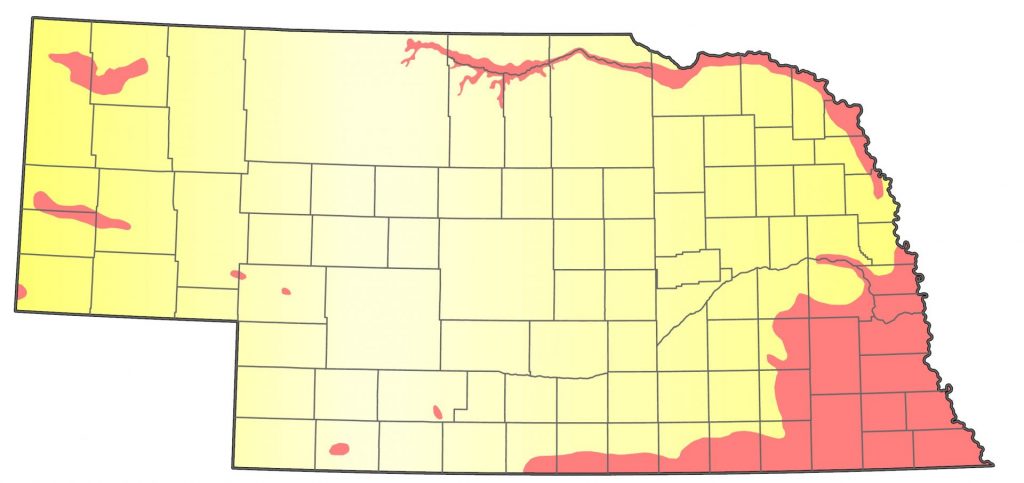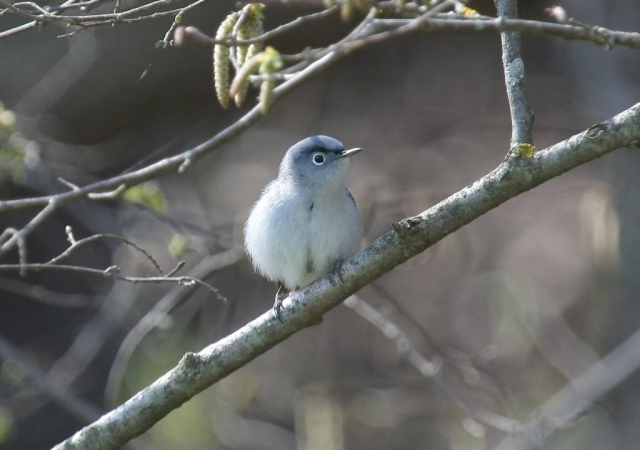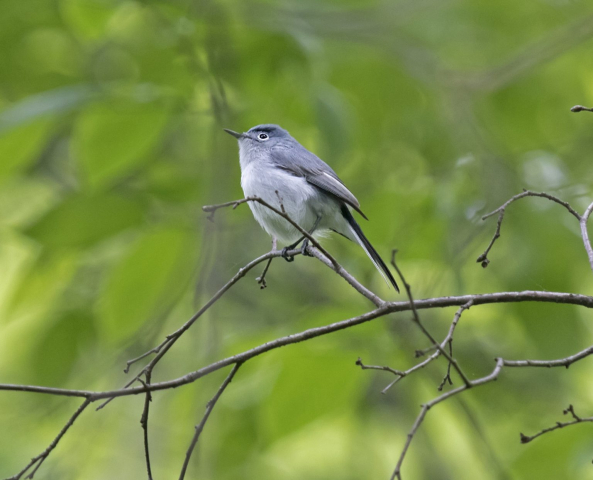Polioptila caerulea caerulea, P. c. obscura
Status: Fairly common regular spring and fall migrant east and west, uncommon central. Common regular breeder east, fairly common north-central, south, and west.
Documentation: Specimen: caerulea, UNSM 11734, 1 May 1888 Peru, Nemaha Co.
Taxonomy: Eight subspecies are recognized (AviList 2025), three breeding north of Mexico: obscura, of California to Wyoming and south to Texas, deppei, of extreme south Texas, and caerulea, from Kansas to central Texas and east to the Atlantic Coast.
Until the 1990s, the only subspecies occurring in the state was eastern caerulea (Rapp et al 1958), but since then presumed western obscura has spread into western Nebraska from the Rocky Mountains. Faulkner (2010) stated that obscura had expanded markedly in Wyoming since the mid-20th century.
In Nebraska, eastern caerulea occupies deciduous and mixed forest in the east and eastern Niobrara River Valley, and western obscura occupies Panhandle pinewoods and recently similar habitat in the west-central Niobrara River Valley (see Summer).
Changes since 2000: In the late 1990s a rapid increase in numbers in the Panhandle began, and since then this species has expanded dramatically to occupy most pine woodland habitat in western Nebraska, including much of the central Niobrara River Valley but not the Sandhills.
Spring: Apr 4, 4, 5 <<<>>> summer (east, central); Apr 22, 24, 25 <<<>>> summer (west)
Earlier dates in the east are 31 Mar 2012 Lancaster Co, 1 Apr 2023 Lancaster Co, and 2 Apr 2013 Seward Co.
Earlier dates in the west are 15 Apr 2024 Wildcat Hills SRA, Scotts Bluff Co, and 17-18 Apr 2024 Ash Hollow SHP, Garden Co.
Arrival in the east is mid- to late Apr and in the west in early May.
Until recently this species was rarely encountered away from the east, with these few reports: a specimen UNSM ZM6707 22 Apr 1937 Lincoln Co (Tout 1947), 28 April 1953 Thomas Co, 4 May 1996 Howard Co, and 12 May 1957 Logan Co.
Following the discovery of breeding in Kimball Co in the late 1990s (see Summer), numbers of spring migrants in the west have increased rapidly. In 1998, 13-15 were found each spring until by 2001 it was becoming “widespread and almost common in the Panhandle” (Stephen J. Dinsmore, personal communication). A count of 19 were at Wildcat Hills SRA, Scotts Bluff Co 3 Jun 2025.
As a migrant, it is least numerous in central Nebraska, as might be expected with stable numbers in the east and increasing numbers in the Panhandle, although numbers in the central in spring have also increased dramatically since 2000. It was still a “rare spring transient” 22 Apr-3 Jun in the Keith Co area (Brown and Brown 2001) at about the same time numbers were increasing rapidly in the Panhandle. Similarly, it was listed as a “Casual spring and fall migrant”, but increasing, in the Rainwater Basin, where Jorgensen (2012) listed 17 total spring reports 9 Apr-25 May. Among the first spring records in central Nebraska were singles in Hitchcock Co 5 May 2003, Buffalo Co 10 Apr 2005, and Garfield Co 15 May 2005.
- High counts: in the east, 45 at Indian Cave SP, Nemaha and Richardson Cos 26 Apr 2014, 45 at Fontenelle Forest, Sarpy Co 22 Apr 2016, and 22 at Towl Park, Omaha, Douglas Co 12 May 2016, and in the west 30 on Old Stage Rd, Scotts Bluff Co 24 May 2007, 16 at Wildcat Hills NC, Scotts Bluff Co 17 Jun 2023, 9 there 28 May 2016, 9 there 24 May 2023., and 9 in Morrill Co 31 May 2025.
Summer: Prior to the late 1990s, this species was confined to the east; Bruner et al (1904), Rapp et al (1958), and Mollhoff (2001a) showed an essentially unchanged distribution for some 100 years primarily in the southeast, although Mollhoff (2001a) stated that it was reported “at scattered sites along the Missouri River as far as its confluence with the Niobrara River”. Merritt Cary listed Blue-gray Gnatcatcher as a “not uncommon migrant” in the Upper Elkhorn Valley, with dates 29 Apr 1999 and 9 May 1898 (Cary 1900). During 2006-2011, however, breeding reports increased in the Missouri River Valley north and west to Dakota and Knox Cos (Mollhoff 2016). The only reports north and east of the Elkhorn River Valley in 1984-1989 were one each for Dakota and Knox Cos (Mollhoff 2001a), but during 2009-2014 there were 13, presumably eastern birds consolidating their range. One of 2-4 birds at Ashford Scout Camp, Thurston Co, was carrying food 11 Jun 2006, the first breeding record in the extreme northeast. Reports increased in Seward, Saline, and Jefferson Cos also (Mollhoff 2016), although it is absent in summer in the Rainwater Basin, where habitat is unavailable or limited (Jorgensen 2012).
Blue-gray Gnatcatcher has been expanding its range northward along Colorado’s eastern foothills for some time, apparently part of a general shift northward there during the last three decades (Hitch and LeBurg 2007, Kershner and Ellison 2020). The first records of this western population reaching Nebraska were on 19 Jun 1993, when a single territorial bird was found in limber pines in western Kimball Co (incorrectly cited 16 Jun in Grzybowski 1993), and another was there 24 Jun 1995. A family group was seen in the same area, including adults feeding dependent young 22 Aug 1999, and four nests with eggs were located there 10-11 Jun 2000 (Mollhoff 2001b). Expansion of the western range northeastward is discussed below.
Mollhoff (2022) pointed out that western birds are found in pines and eastern birds in deciduous forest.
In the Wildcat Hills, Scotts Bluff and Banner Cos, one was on Stage Hill Road 6 Sep 1997 and several birds were located in spring 1998 in suitable breeding habitat. Numbers increased rapidly, with 21 counted 30 Jul 2000, and, in 2015, the “highest number ever banded in a season at Wildcat Hills NC” was the 21 during 24 Aug-23 Sep. On the Bighorn Escarpment, one was found 12 Sep 1997 and again in spring 1998 in Long Canyon and a single bird was reported south of Redington, Morrill Co 30 Aug 1997; three nests, two with eggs, were found there 11 Jun 2000 (Mollhoff 2001b) and 25-30 birds, including what appeared to be a few juveniles, were present 11-12 Aug 2001.
In the northern Panhandle, first records were of a single bird in Box Butte Co 2 Jun 1996 (Grzybowski 1996), two at the north end of Sowbelly Canyon, Sioux Co 6 Jul 2002, and another in Sioux Co 30 Aug 2003. Eastward on the Pine Ridge were two at Chadron SP, Dawes Co 11 Jun 2015. Elsewhere in the Panhandle, two were at Ash Hollow SHP, Garden Co 21 Sep 2003 and another two 5 Jun 2005; singles were near Crescent Lake NWR, Garden Co 7 Sep 1998 and 12 May 1999, and 1-2 were there 24 Jun 2005. Singles were at Smith Lake WMA, Sheridan Co during 10-23 May 2003 and 4 Jun 2008 and two were there 1 Jul 2017. A nest with young was near Kimball, Kimball Co 29 Jun 2007 (Mollhoff 2022).
In the Niobrara River Valley, Mollhoff (2001a) had stated that it was reported “at scattered sites along the Missouri River as far as its confluence with the Niobrara River”, and Ducey (1989) suggested that this species was “extending its range into the lower Niobrara Valley” and would be “expected to breed there”. However, the only indication of westward spread in the Niobrara River Valley beyond Knox Co prior to 2007-2009 is a single record from Holt Co 4 Sep 2006; except for this record there was a gap in reports between Knox Co and northeast Cherry Co until 2015. It is likely, based on first report dates, that gnatcatchers reached northeastern Cherry Co from the southwest via Crescent Lake NWR and NNF Bessey in Thomas Co. The first Crescent Lake NWR report was in 1999, and there were numerous reports there beginning in 2008 and at NNF Bessey beginning 21 May 2009. One was at Hyannis, Grant Co 17 May 2009. The first reports in northeast Cherry Co were of one there 25 Aug 2007, two at Fort Falls 18 Aug 2008, and one at Fort Niobrara NWR 22 Sep 2009. The gap in reports mentioned above in the Niobrara River Valley east of Cherry Co was closing by 2015, however, as there were reports suggestive of western birds moving eastward; there were several sightings of up to four between Fort Niobrara NWR and the Niobrara Valley Preserve, Brown and Keya Paha Cos 14-29 Jun 2015, and one at Fred Thomas WMA, Rock Co 29 Jun 2019. Two near Norden, Keya Paha Co 8 Jun 2022 and one along Anderson Bridge Road, Cherry Co 29 May 2022 were identified as western subspecies obscura. Nesting was reported at Fort Niobrara NWR, Cherry Co in 2021 (Renee Tressler, personal communication). Two near Royal, Antelope Co 4 Jun 2017 may have been spring migrants.
There are about 30 reports in the central between the Platte and Niobrara river valleys, notably at NNF Bessey and nearby riparian areas.
In the Platte River Valley, prior to the arrival of western birds in the 1990s, there had been two westerly reports of presumed vagrant eastern birds; a Lincoln Co specimen UNSM ZM6707 taken 22 Apr 1937, listed as caerulea (Tout 1947), and an 11 Jun 1985 report. A female in breeding condition netted at Cedar Point Biological Station, Keith Co, 3 Jun 1993 (Rosche 1994) was not identified to subspecies, but by year of occurence likely caerulea. A nest found there in 2010 was claimed as “the first nest of Blue-gray Gnatcatcher (Polioptila caerulea) in western Nebraska” (Barcelo and Faaborg 2012), although it was preceded by those described above in Kimball Co. The 2010 Keith Co nest was parasitized by a Brown-headed Cowbird and the pair apparently re-nested (Barcelo and Faaborg 2012, Brown et al 2012). As of 2016 it was a regular, localized breeder in low numbers in the Lake Ogallala area, Keith Co (Mary B. Brown, personal communication). Reports are increasing in the Platte River Valley from Dawson to Dodge Cos; as of Jul 2024, there are about 15 records for Jun-Jul, including documented caerulea, all since 2013.
In the Republican River Valley, eastern birds appear to have been established prior to the arrival of western birds; a territorial pair was seen in riparian woodland south of Orleans, Harlan Co 6 Jun 1990, three were there 23 Jun 1996, and another on 20 Jul 2000. More recent westerly reports, such as one at Swanson Reservoir, Hitchcock Co 5 May 2003 and two there 28 Jun 2024, at Oxford, Furnas Co 30 Apr 2006, Hayes Co 9 Jun 2024, and in Frontier Co 10 Jun 2009 (Brogie 2009), 25 May 2010, and 4 Jun 2024 may have been western obscura, although one recorded at Medicine Creek SRA, Frontier Co 24 May 2021 was eastern caerulea. A recording of one southwest of Callaway, Custer Co 15 Jul 2024 appeared to be of obscura.
- Breeding phenology:
Dates below have been separated into eastern and western reports, since different subspecies are Involved.- East:
Nest building: 24 Apr-8 Jun
Eggs: 1 May-10 Jun - Nestlings: 11 May-11 Jul
Fledglings: 22 Jun-15 Jul - West:
Nest building: 14 May-2 Jun
Eggs: 15 Jun-1 Jul
Nestlings: 10 Jun
Fledglings: 29 Jun
- East:
Fall: summer <<<>>> Oct 6, 6, 7
Later dates are 11 Oct 2015 Dundy Co, and 25 Nov 2016 Keith Co.
Departure is usually completed by late Sep in both east and west.
- High counts: 13 at Wildcat Hills SRA, Scotts Bluff Co 17 Aug 2022, 12 at Carter Canyon, Scotts Bluff Co 30 Aug 2006, 12 in Long Canyon, Banner Co, 24 Aug 2008, 11 in the Wildcat Hills, Scotts Bluff Co 4 Sep 1999, and 11 at Wilderness Park, Lancaster Co 29 Aug 2024.
Images
Abbreviations
NC: Nature Center
NNF: Nebraska National Forest
NWR: National Wildlife Refuge
SHP: State Historical Park
SP: State Park
SRA: State Recreation Area
UNSM: University of Nebraska State Museum
Literature Cited
AviList Core Team, 2025. AviList: The Global Avian Checklist, v2025. https://doi.org/10.2173/avilist.v2025.
Barcelo, I., and J. Faaborg. 2012. Expansion of the breeding range of the Blue-Gray Gnatcatcher (Polioptila caerulea) Into western Nebraska. Southwestern Naturalist 57: 478-479.
Brogie, M.A. 2009. 2009 (21st) Report of the NOU Records Committee. NBR 77: 160-168.
Brown, C.R., and M.B. Brown. 2001. Birds of the Cedar Point Biological Station. Occasional Papers of the Cedar Point Biological Station, No. 1. Nebraska, USA.
Brown, M.B., S.J. Dinsmore, and C.R. Brown. 2012. Birds of Southwestern Nebraska. University of Nebraska-Lincoln, Lincoln, Nebraska, USA.
Bruner, L., R.H. Wolcott, and M.H. Swenk. 1904. A preliminary review of the birds of Nebraska, with synopses. Klopp and Bartlett, Omaha, Nebraska, USA.
Cary, M. 1900. Some bird notes from the Upper Elkhorn. Proceedings of the NOU 1: 21-29.
Ducey, J.E. 1989. Birds of the Niobrara River valley, Nebraska. Transactions of the Nebraska Academy of Sciences 27: 37-60.
Faulkner, D.W. 2010. Birds of Wyoming. Roberts and Company, Greenwood Village, Colorado Jorgensen, J.G. 2012. Birds of the Rainwater Basin, Nebraska. Nebraska Game and Parks Commission, Lincoln, Nebraska, USA.
Grzybowski, J.A. 1993. Southern Great Plains Region. American Birds 47: 1122-1124.
Grzybowski, J.A. 1996. Southern Great Plains Region. Field Notes 50: 965-968.
Hitch, A.T., and P L. Leberg. 2007. Breeding distributions of North American bird species moving north as a result of climate change. Conservation Biology 21: 534-539.
Jorgensen, J.G. 2012. Birds of the Rainwater Basin, Nebraska. Nebraska Game and Parks Commission, Lincoln, Nebraska, USA.
Kershner, E.L. and W.G. Ellison. 2020. Blue-gray Gnatcatcher (Polioptila caerulea), version 1.0. In Birds of the World (A. F. Poole, Editor). Cornell Lab of Ornithology, Ithaca, NY, USA. https://doi.org/10.2173/bow.buggna.01.
Mollhoff, W.J. 2001a. The Nebraska Breeding Bird Atlas 1984-1989. Nebraska Ornithologists’ Union Occasional Papers No. 7. Nebraska Game and Parks Commission, Lincoln, Nebraska, USA.
Mollhoff, W.J. 2001b. 1999-2000 Nebraska nesting report. NBR 69: 92-101.
Mollhoff, W.J. 2016. The Second Nebraska Breeding Bird Atlas. Bull. Univ. Nebraska State Museum Vol 29. Univ. Nebraska State Museum, Lincoln, Nebraska, USA.
Mollhoff, W.J. 2022. Nest records of Nebraska birds. Nebraska Ornithologists’ Union Occasional Paper Number 9.
Rapp, W.F. Jr., J.L.C. Rapp, H.E. Baumgarten, and R.A. Moser. 1958. Revised checklist of Nebraska birds. Occasional Papers 5, Nebraska Ornithologists’ Union. Crete, Nebraska, USA.
Rosche, R.C. 1994. Birds of the Lake McConaughy area and the North Platte River valley, Nebraska. Chadron, Nebraska, USA.
Tout, W. 1947. Lincoln County birds. North Platte, Nebraska, USA.
Recommended Citation
Silcock, W.R., and J.G. Jorgensen. 2025. Blue-gray Gnatcatcher (Polioptila caerulea). In Birds of Nebraska — Online. www.BirdsofNebraska.org
Birds of Nebraska – Online
Updated 27 Aug 2025, map updated 24 August 2023


